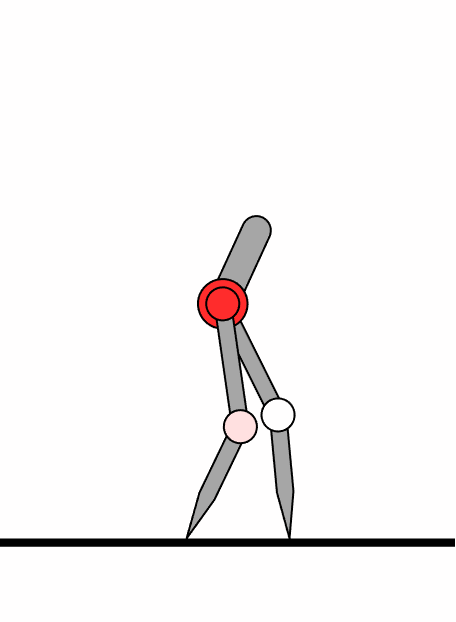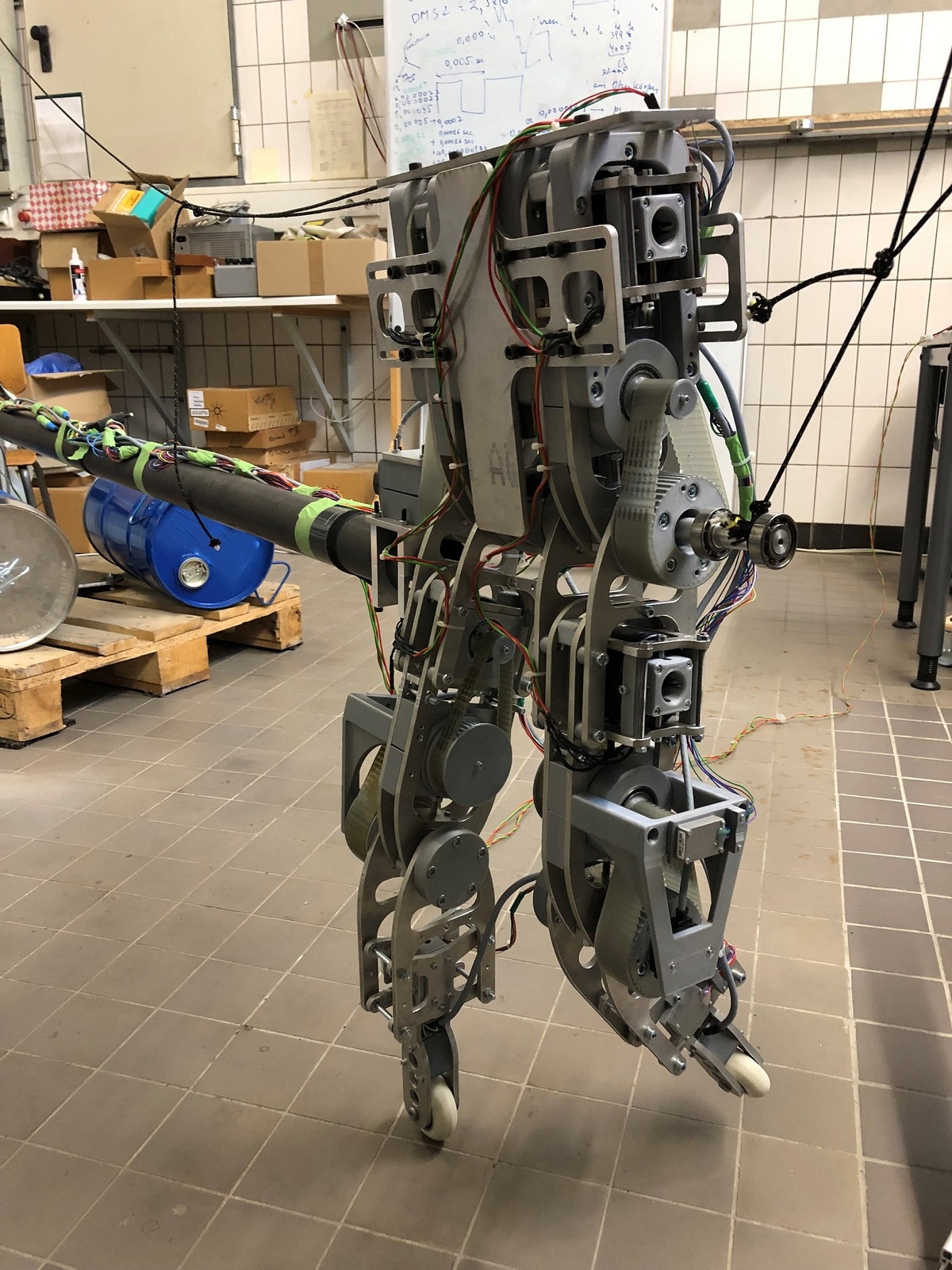
M.Sc. Yinnan Luo
- Wissenschaftlicher Mitarbeiter
- Raum: 206.2
- Tel.: +49 721 608-47623
- yinnan luo ∂does-not-exist.kit edu
Postanschrift:
Karlsruher Institut für Technologie
Institut für Technische Mechanik
Teilinstitut Dynamik/Mechatronik
Postfach 6980
76049 KarlsruheHaus- und Lieferanschrift:
KIT-Campus Süd
Institut für Technische Mechanik
Teilinstitut Dynamik/Mechatronik
Geb. 10.23, R 206.2
Kaiserstraße 10
76131 Karlsruhe
Design of bipedal robots with optimized energy efficiency in varying environments
In the development of biped robots, energy efficient locomotion via walking or running is a major research priority. Due to the limited energy storage (battery), energy efficiency significantly determines the walking distance that can be covered. Energy efficiency depends not only on the controller used for stabilizing the motion, but also on the structural design and its mechanical model parameters. Hence, the purpose of this research is to develop and apply a method to systematically optimize the structure of a bipedal robot to maximize energy efficiency in different environments.
In the first step we consider an underactuated robot model which consists of five segments. Its rigid segments are additionally connected by elastic couplings such as torsion springs. Knowing that the robot’s periodic walking or running gaits can be analyzed as limit cycles of the controlled mechanical system, its resonance frequency can be adjusted to match the current step frequency by modifying the elastic couplings. A systematic approach to achieve this matching consists in the simultaneous optimization of the elastic couplings and the controlled motion. Consequently, the robot exploits the mechanical system's natural dynamics instead of wasting energy on its suppression.
Since the optimization of the parameters essentially depends on the conditions of the environment and the gait, the focus is on how the adaptation of the robot to the current operating state can be realized. Unlike the motion, which can be continuously updated by the controller based on the measured state variables, the elastic couplings need to be optimized to achieve the best characteristics by using "compliant smart mechanics" (COSM). Between the stance and swing phases of the robot’s legs, and especially during switching processes of the movement, an optimal (force-displacement and/or force-velocity) characteristic of COSM leads to an overall high energy efficiency for a wide range of walking scenarios.
This project is being carried out jointly by two research groups: The Compliant Systems Group (FG NSYS) from the Ilmenau University of Technology (TU Ilmenau) and the Institute of Engineering Mechanics (ITM) from the Karlsruhe Institute of Technology (KIT). While the team at TU Ilmenau investigates the compliant mechanical systems and their design and implementation, the team at KIT simulates and optimizes bipedal robots with those COSM mechanisms in different environments. It is financially supported by the German Research Foundation (DFG), grant FI 1761/4-1 | ZE 714/16-1.
Project partner: Prof. L. Zentner, M. Zirkel.
Contact: Prof. A. Fidlin, Y. Luo, A. Mukherjee.
Publikationen
Luo, Y.; Römer, U. J.; Zirkel, M.; Zentner, L.; Fidlin, A.
2024. Advances in Nonlinear Dynamics, Volume II – Proceedings of the Third International Nonlinear Dynamics Conference (NODYCON 2023). Editor: Walter Lacarbonara, 73–82, Springer Nature Switzerland. doi:10.1007/978-3-031-50639-0_7
Luo, Y.; Römer, U.; Zirkel, M.; Zentner, L.; Fidlin, A.
2024. Zehnte IFToMM D-A-CH Konferenz 2024 : 05./06. März 2024, Universität Rostock, DuEPublico. doi:10.17185/duepublico/81582
Zirkel, M.; Luo, Y.; Römer, U. J.; Fidlin, A.; Zentner, L.
2023. Microactuators, Microsensors and Micromechanisms – MAMM 2022. Ed.: A. Pandey, 46–60, Springer International Publishing. doi:10.1007/978-3-031-20353-4_4
Luo, Y.; Römer, U. J.; Riegraf, S.; Fidlin, A.; Zirkel, M.; Zentner, L.
2021. 3. VDI-Fachtagung: Schwingungen 2021 ; Würzburg, 16. und 17. November 2021, 259–272, VDI Verlag. doi:10.51202/9783181023914-259
Luo, Y.; Römer, U. J.; Zentner, L.; Fidlin, A.
2022. Advances in Nonlinear Dynamics – Proceedings of the Second International Nonlinear Dynamics Conference (NODYCON 2021), Volume 2. Ed.: W. Lacarbonara, 253–262, Springer International Publishing. doi:10.1007/978-3-030-81166-2_23
Luo, Y.; Zirkel, M.; Römer, U. J.; Zentner, L.; Fidlin, A.
2021. Proceedings in applied mathematics and mechanics, 21 (1), e202100197. doi:10.1002/pamm.202100197
Luo, Y.; Römer, U. J.; Fidlin, A.
2021. Proceedings in applied mathematics and mechanics, 20 (1), e202000142. doi:10.1002/pamm.202000142
Zirkel, M.; Luo, Y.; Römer, U. J.; Fidlin, A.; Zentner, L.
2021. Microactuators, Microsensors and Micromechanisms : MAMM 2020. Ed.: L. Zentner, 58–75, Springer International Publishing. doi:10.1007/978-3-030-61652-6_6
| Titel | Tagung |
|---|---|
| Optimierte Energieeffizienz des zweibeinigen Gehens auf nachgiebigem Untergrund durch elastische Kopplung | IFToMM D-A-CH 2024 |
| Improving Energy Efficiency of a Bipedal Walker with Optimized Nonlinear Elastic Coupling | NODYCON 2021 |
| Improving Energy Efficiency of Bipedal Walking Using Nonlinear Compliant Mechanisms | GAMM 2020/2021 |
| Energy Efficiency of a Bipedal Robot That Walks on Compliant Ground | GAMM 2023 |
| Efficient Bipedal Walking on Stairs Using Compliant Mechanisms | GAMM 2022 |
| Efficiency Study of the Non-Instantaneous Double Support Phase in HZD Controlled Bipedal Robot | Nodycon 2023 |
| Design of a Robot Prototype to Investigate and Improve Bipedal Walking Efficiency | International Conference on Machine Design 2021 |
| Anwendung einer Homotopie-Optimierungs-Methode zur Identifikation der Modellparameter eines Roboterprototyps | 3. VDI-Fachtagung Schwingungen 2021 |


